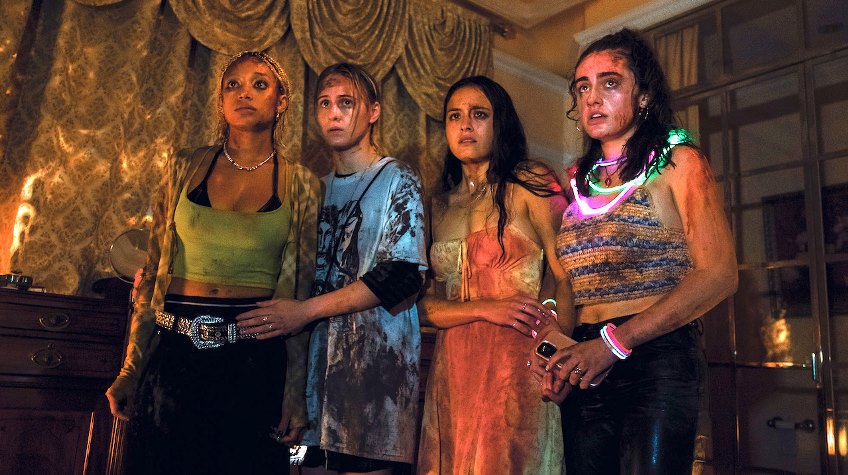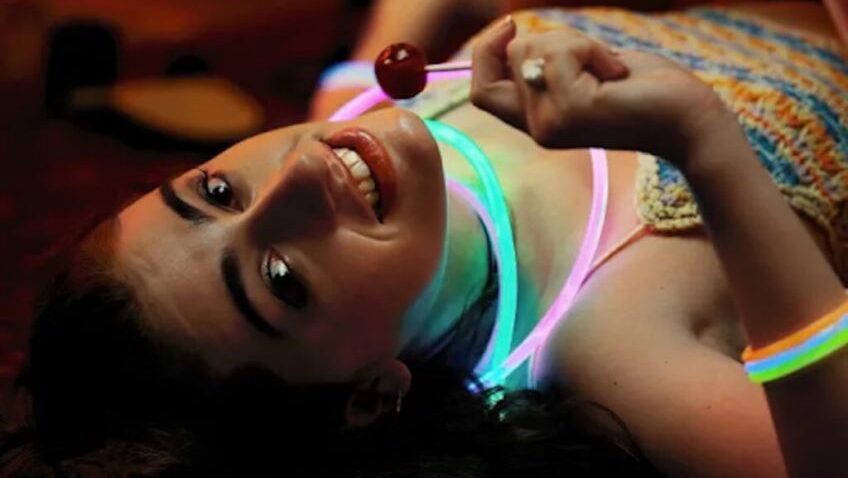Joyce Glasser reviews Bodies, Bodies, Bodies (September 2, 2022) Cert 15, 94 mins.
In the opening scene of Halina Reijn’s Bodies, Bodies, Bodies, written by Sarah Lelappe from a story by Kristen Roupenian, there is a big weather and a tonal change after the short opening scene. Here, birds chirp in the sunshine and, in a close up, two young women, Sophie (Amandla Stenberg), a wealthy Black woman in her early twenties, and Bee (Maria Bakalova) a working class, Eastern European off blonde with a distracted look, kiss. “I love you” Sophie tells Bee, not expecting her to return the declaration. We wonder if this is the end of a long relationship but later learn they’ve known each other what is a long time in their circles – a staggering six weeks. And not very well.
Bodies, Bodies, Bodies, might be a spoof of the dark horror genre, or a comedy, but it’s definitely a Generation Z horror movie, and Reign manages to convince us that there’s no kind of movie about Generation Z that wouldn’t be. Long before the parlour game that lends the film its title begins, most over fifties will be at best uncomfortable, and most likely horrified at the prospect of spending an hour, let alone a weekend with this group of, err… friends.
After their kiss, the angle widens to a car winding its way over a narrow cliff town path to the remote estate owned by the absent parents of Sophie’s childhood friend David (Pete Davidson), the host. God only knows why his parents would leave their palatial home in David’s care, but it happens so often in movies that it seems to us that parents never learn.
This is just the first of many tropes of the House Party Weekend genre that Reijn uses for comic effect. But what differentiates this film from most others is how unstable, erratic, vexatious, disparaging and nasty the guests are.
When Sophie (who is not expected and for some, unwanted) and Bee, an outsider, arrive, the house party is already in full swing around the pool. There are Emma (Chase Sui Wonders) a would-be actress; Jordan (Myha’la Herrold), David’s former girlfriend, whose parents are professors, and so are of a lower economic class than the others; and Alice (Rachel Sennott), a spaced out podcaster wearing coloured beads around her neck and a red bikini. Alice has invited an older man, like Bee, an outsider, named Greg (Lee Pace).

There is also Max (Conner O’Malley), who, early on, has a fight with David and leaves: or does he? David has been left with a big black eye and his face looks swollen, but he doesn’t seem to mind. When he asks Sophie why she’s there, she says she missed him. ‘No one misses me,’ he retorts. There is a backstory between the two and the accusations begin when Jordan accuses Sophie, who has been in rehab for drug addiction, of using David to get her Trust Fund back
Just before the storm the guests drink, take drugs and dance. But this is never an ordinary party. Greg is seen to be opening a bottle of champagne with a kukri knife, which is the first clue that Greg is handy with weapons. He has skill as he was a Vet, which the others interpret to mean that he was a former soldier, never expecting that he was a really a veterinarian.
Jordan, who is flirting with Bee to get at Sophie, asks Bee if she is from Moscow. Bee asks why she thinks so. ‘Dr Zhivago is my favourite movie,’ is the answer. Welcome to Generation Z.
When the storm begins Sophie suggests an old murder game, Bodies, Bodies, Bodies, and David explains the rules. Greg is the first corpse but after an argument with David, soon tires of the young crowd and announces he is going to bed. David quits shortly thereafter after an argument with Emma.
Then the power goes out (another trope of course, even in a mansion which would have a generator if not a security alarm). Bee discovers David outside with his throat slashed, and that blood-stained kukri nearby. The group become hysterical and scramble to Sophie’s car but, naturally the battery is dead (another trope), and no phones have signals (ditto).

Greg is suspected as David’s killer and the women confront him sleeping (for some reason) in the gym. Alice defends Greg saying ‘he’s a nice guy’ but it turns out she has known him all of two weeks. When they accuse him of murder Greg thinks they are joking, but when they turn threatening, he turns hostile, you might say, in self-defence. A struggle ensues and Bee kills him with a kettle bell. Is she a heroine or a murderer using this as a cover up?
This ridiculous game of chaotic elimination continues in Agatha Christie’s And Then There Were None fashion. In between the discovery of new bodies old grudges, jealousies and recriminations surface and find expression in tit for tat shouting matches. When Sophie is accused of cheating on Bee with Jordan, she denies it, saying Jordan is unreliable and “only hate-listens” to Alice’s podcast. Alice, hurt at this insult, in turn insults Jordan who shoots her in the leg.
Nothing makes sense and in place of a normal anatomy you suspect these twenty somethings are made of short fuses programmed to go off at the slightest injury to their negligible sense of self-worth and insecure egos. It might be a blessing in disguise that they die suddenly, before the lifeblood is slowly drained out of their insipid lives. There is not an intelligent conversation (or a conversation) throughout the weekend and no one you can possibly relate to. The Who Dun It ending is perfect.




